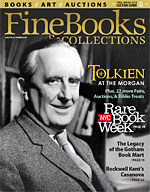Buildings and Books
An inside look at the (designer) bookshelves of twelve world-famous architects. By Stevan Alburty
Unpacking My Library: Architects and Their Books
Edited by Jo Steffens; featuring an essay by Walter Benjamin; Yale University Press in association with Urban Center Books and The Architecture Bookstore of the Municipal Art Society of New York; 182 pages; color photos throughout; paper-over-board; $20.00. Buy@The Fine Books Store
I am not unpacking my library. No, I’m not.
I’ve just completed a move from Manhattan to the mountains. My ancient, sagging bookshelves were left curbside to be brutally chucked into the maw of a municipal garbage truck. As winter approaches, my books shiver in an upstate New York storage unit, awaiting new bookcases that have yet to be ordered due to my inability to decide what to buy and where to put them in my cabin.
It was conveniently auspicious, therefore, when I was asked to review a compact little volume called Unpacking My Library: Architects and Their Books. Who better, I thought, to guide me towards some decisions than twelve world-famous architects?
Each was interviewed about his professional and personal collections; each recommended ten books; and each granted a photographer time to take numerous photographs of shelf after shelf of his books. Who wouldn’t like to be left alone in the studios of Michael Graves, Henry N. Cobb, or Peter Eisenman to see not just what they’re reading or have read, but how these great architects, who suffer the limitation of placing a single building here and there among the great cityscapes of the world, behave given the ability to create limitless skylines of books on a shelf?
Michael Sorkin designed a jubilant glass mushroom of a hotel in Tianjin, China, that looks as if it’s poised to dance “The Nutcracker Suite” along with its fellow fungi from “Fantasia.” For his books, he selected stylish, mobile, laser-cut powdered aluminum KEEP storage units from Keller Easterling.
Steven Holl, whose product designs include a “riddled” cabinet with snap-together orthogonal frames, went with simple ash-painted plywood from a local cabinet-maker. No harm there. Cobbler’s children, after all.
It is in the book’s interviews, where the revelations promised in this title about the relationship between architects and their books are artfully divulged.
“A book lasts longer than a building; books are more important in the world than buildings,” Peter Eisenman gracefully admits. Books give buildings and their architects life-spans that far exceed the mortality of men and mortar. “Without The Four Books on Architecture of Palladio,” Eisenman writes, “no one would have cared about Palladio … Without Rem Koolhaas’s Delirious New York there would be no Koolhaas.”
Stan Allen’s 1,800 titles represent, for him, a “cut across fields of knowledge” and reflect a centuries-old exploration by architects into philosophy and even linguistics as source material. Today he sees architecture itself as “capable of sustaining dense argument without recourse to concepts from outside the field.”
Some of the dense questions and arguments presented here may be too heady for those outside the field. Steven Holl is asked, “Phenomenology … It’s a tricky subject with many trap doors, and now post-phenomenology has arrived at the gates of theology. Is there a limit to the appropriation of the phenomenological by architecture?”
“Wittgenstein wrote that there’s no such thing as phenomenology,” replies Holl, who then goes on to explain his company’s work in terms that will send you leaping for your Heidegger.
Each architect’s top ten recommendations will become shopping lists for serious collectors and readers. Michael Graves includes Robert Venturi’s Complexity and Contradictions in Architecture, as well as J.N.L. Durand’s Recueil et parallèle des édifices en tout genre, anciens et modernes. Toshiko Mori is one of several who swear by John Hejduk. When the lists include fiction, the choices seem requisite: Pynchon and Joyce pop up frequently.
The top ten list offered by Tod Williams and Billie Tsien tweaks and teases all that have come before with some joyous choices: James Cain’s Double Indemnity, Hardie Gramatky’s Creeper’s Jeep, and Crockett Johnson’s Harold and the Purple Crayon. Where is The Fountainhead, one wonders?
Unpacking My Library: Architects and Their Books begins with an essay from Illuminations by Walter Benjamin. I began this review with a paraphrase of the opening line of Benjamin’s essay on his own love of books and collecting: “I am unpacking my library. Yes, I am.”
As for me, my bookshelves have been ordered, and the books will soon be warm and treasured in their new home. I will be transformed, once again, into a collector. “So I have erected one of his dwellings,” writes Benjamin, “with books as the building stones, before you, and now he is going to disappear inside, as is only fitting.”








